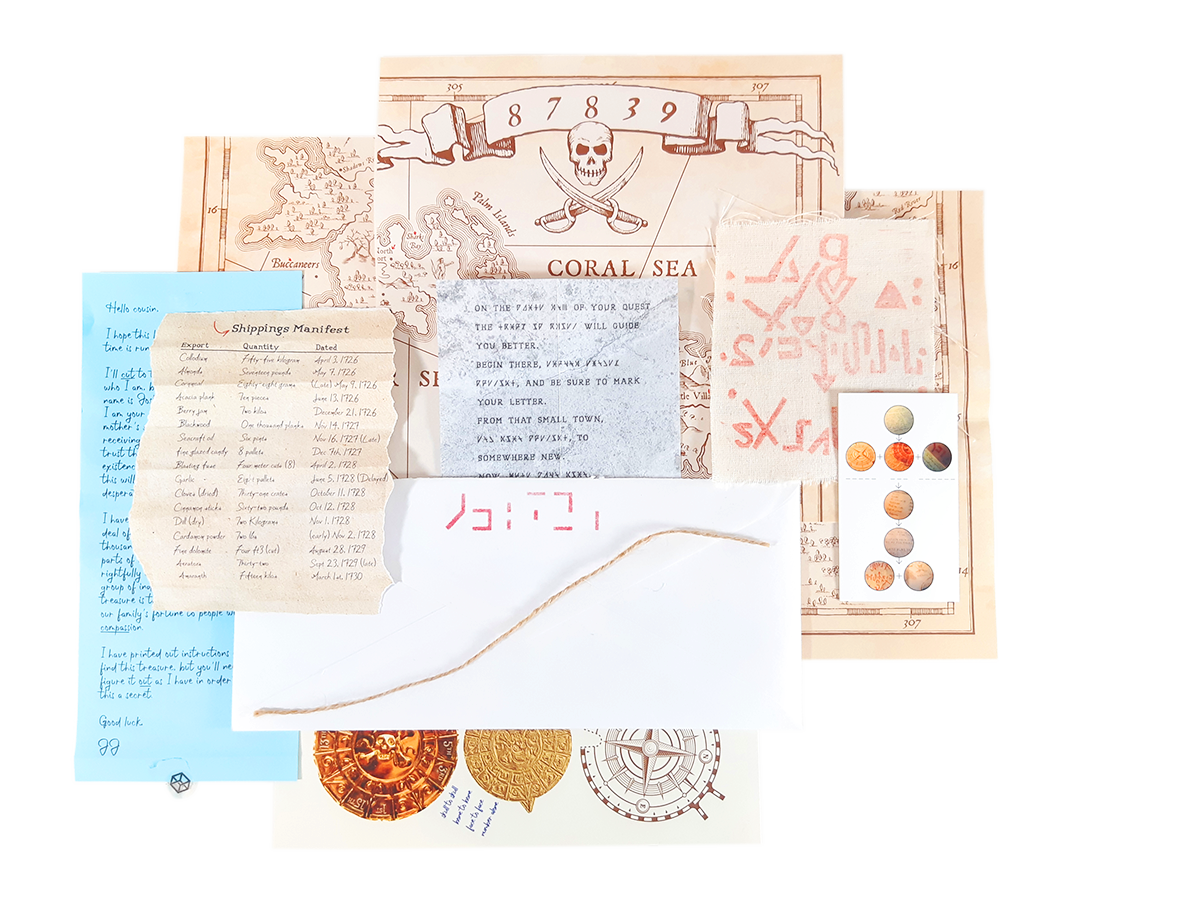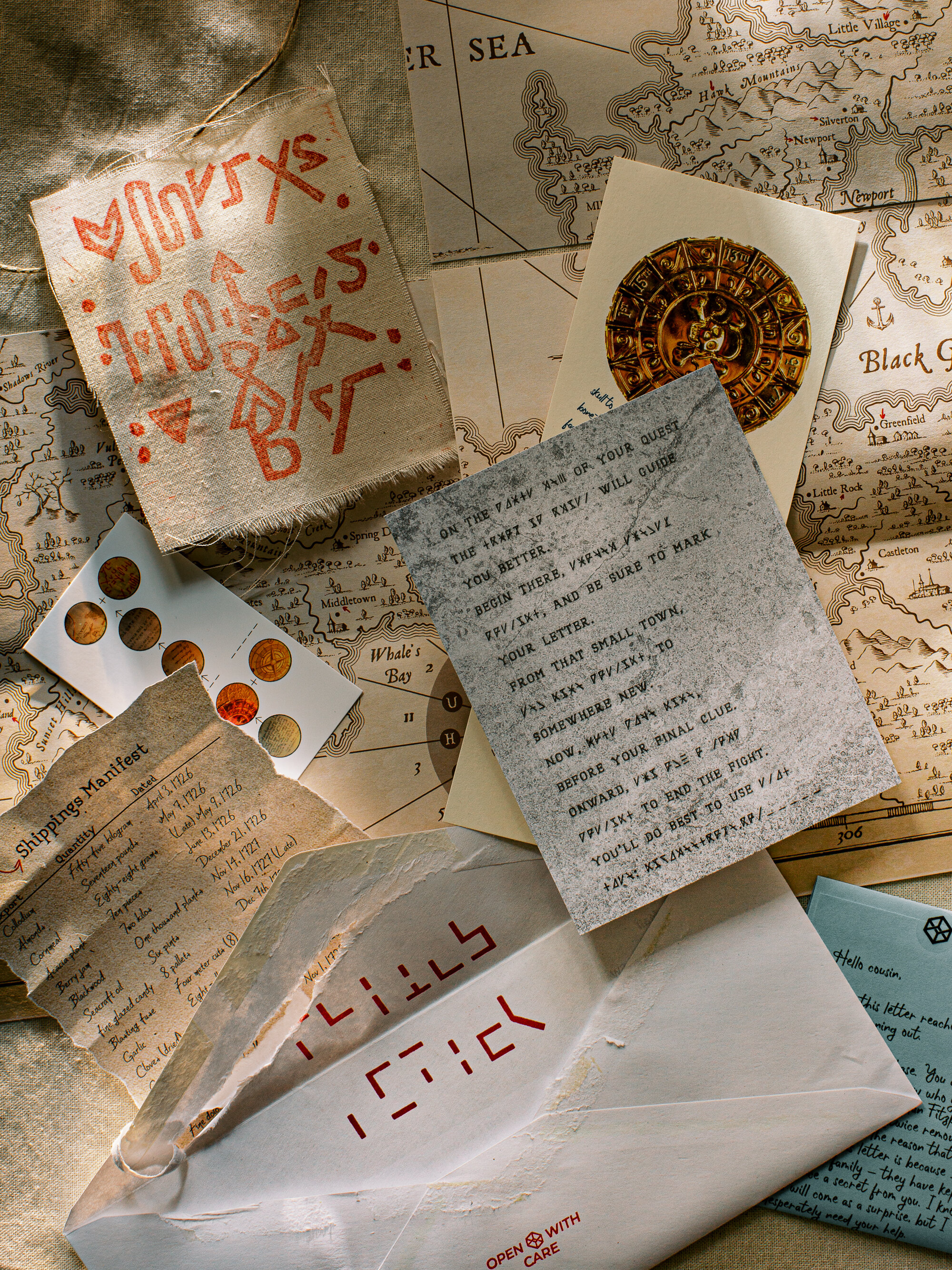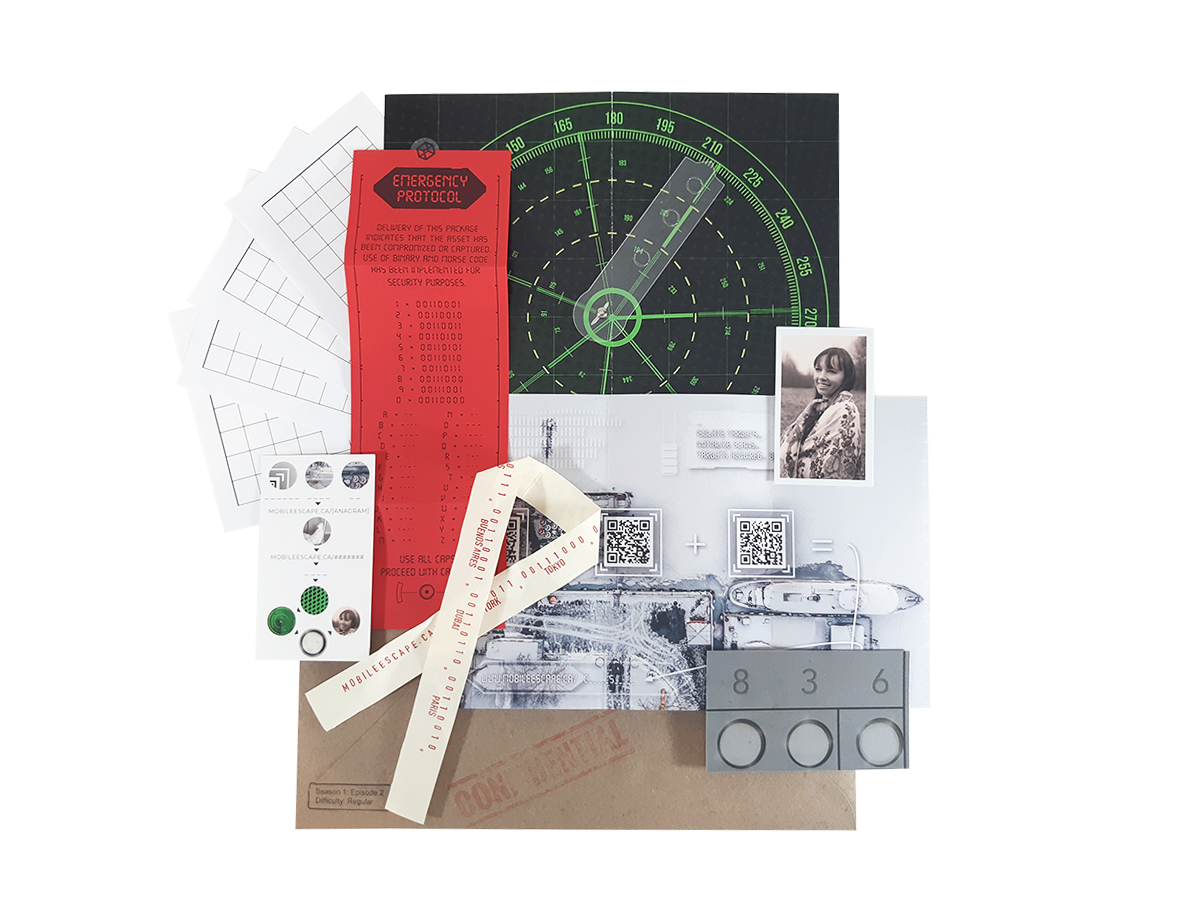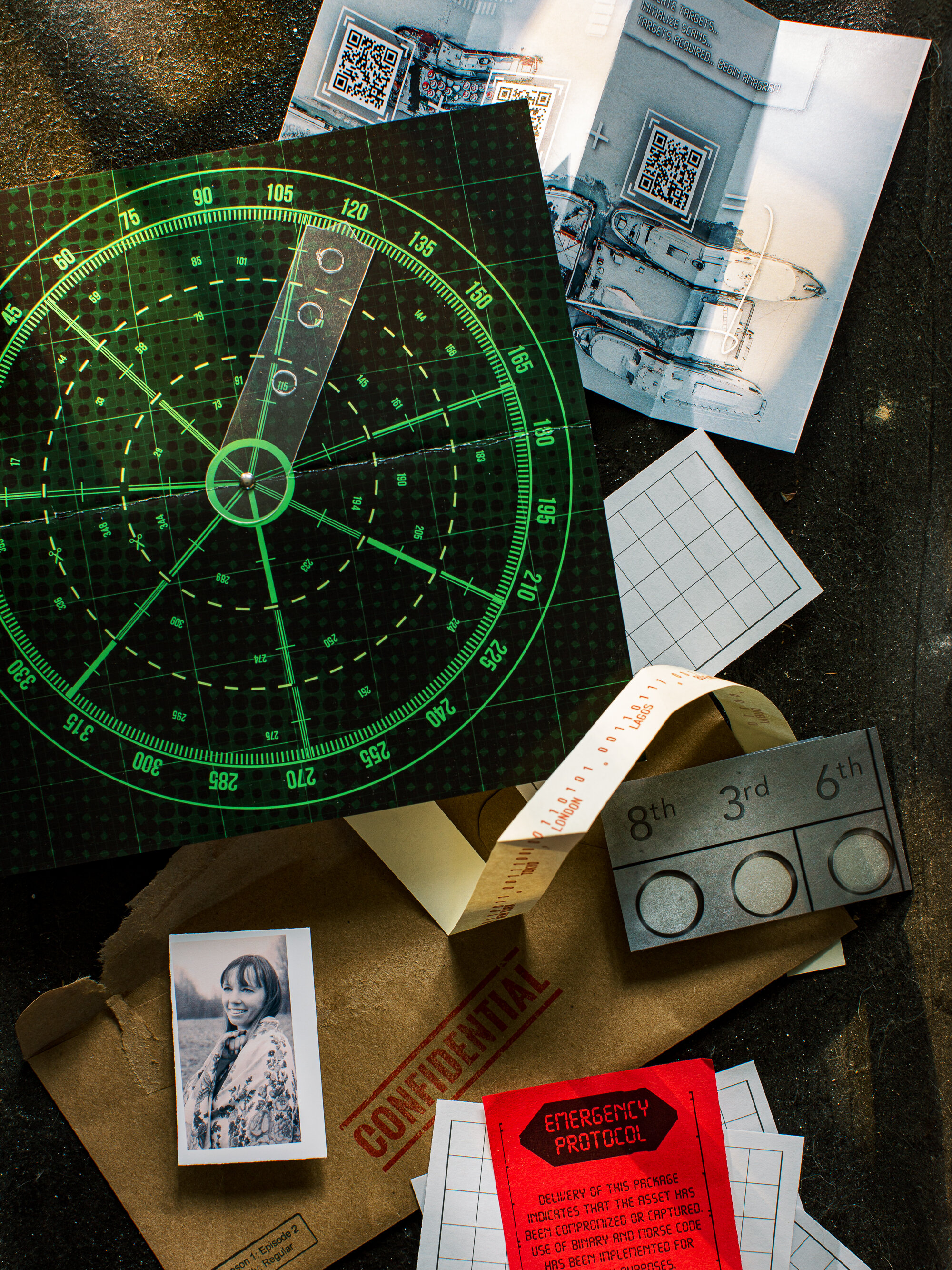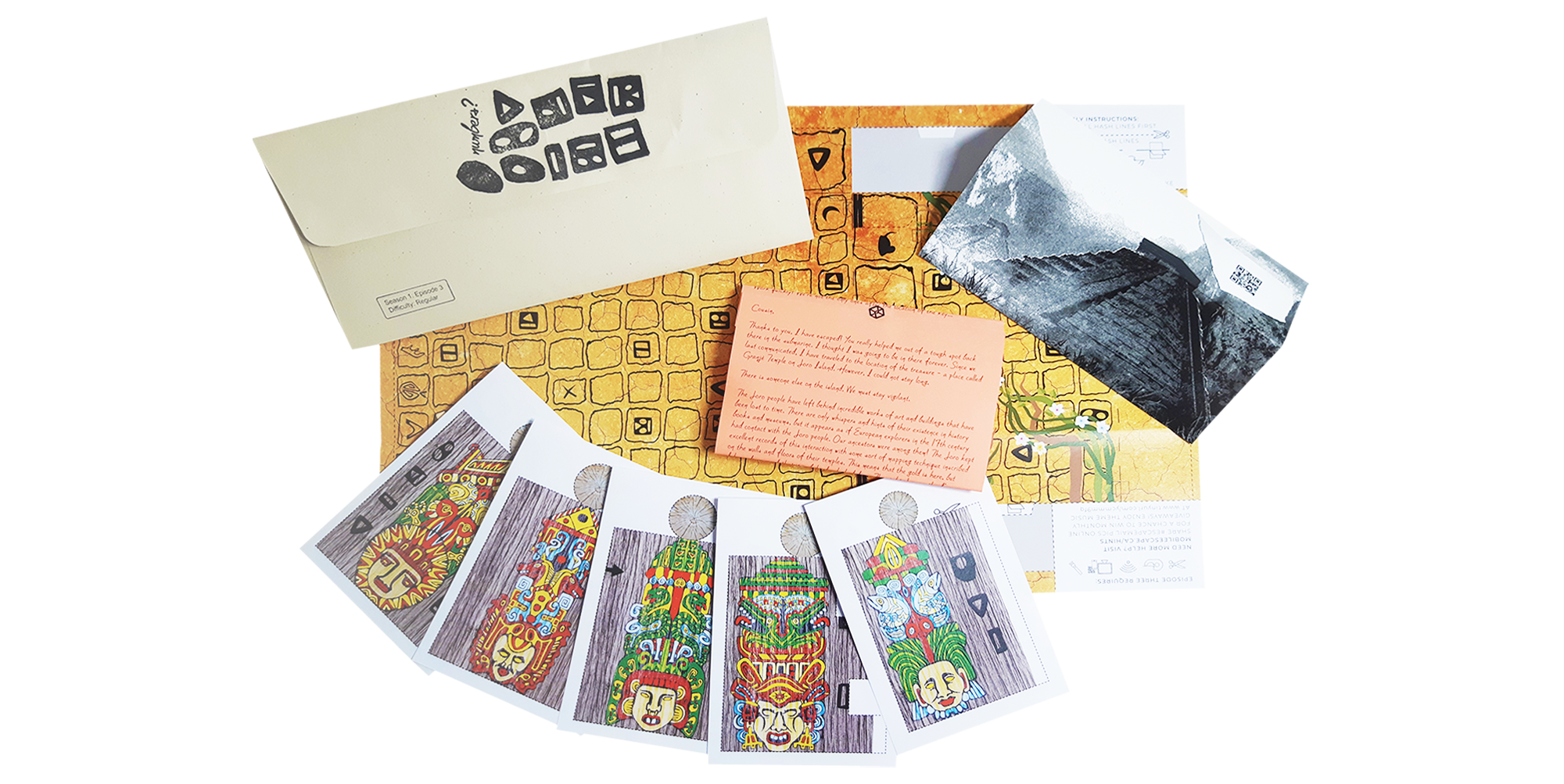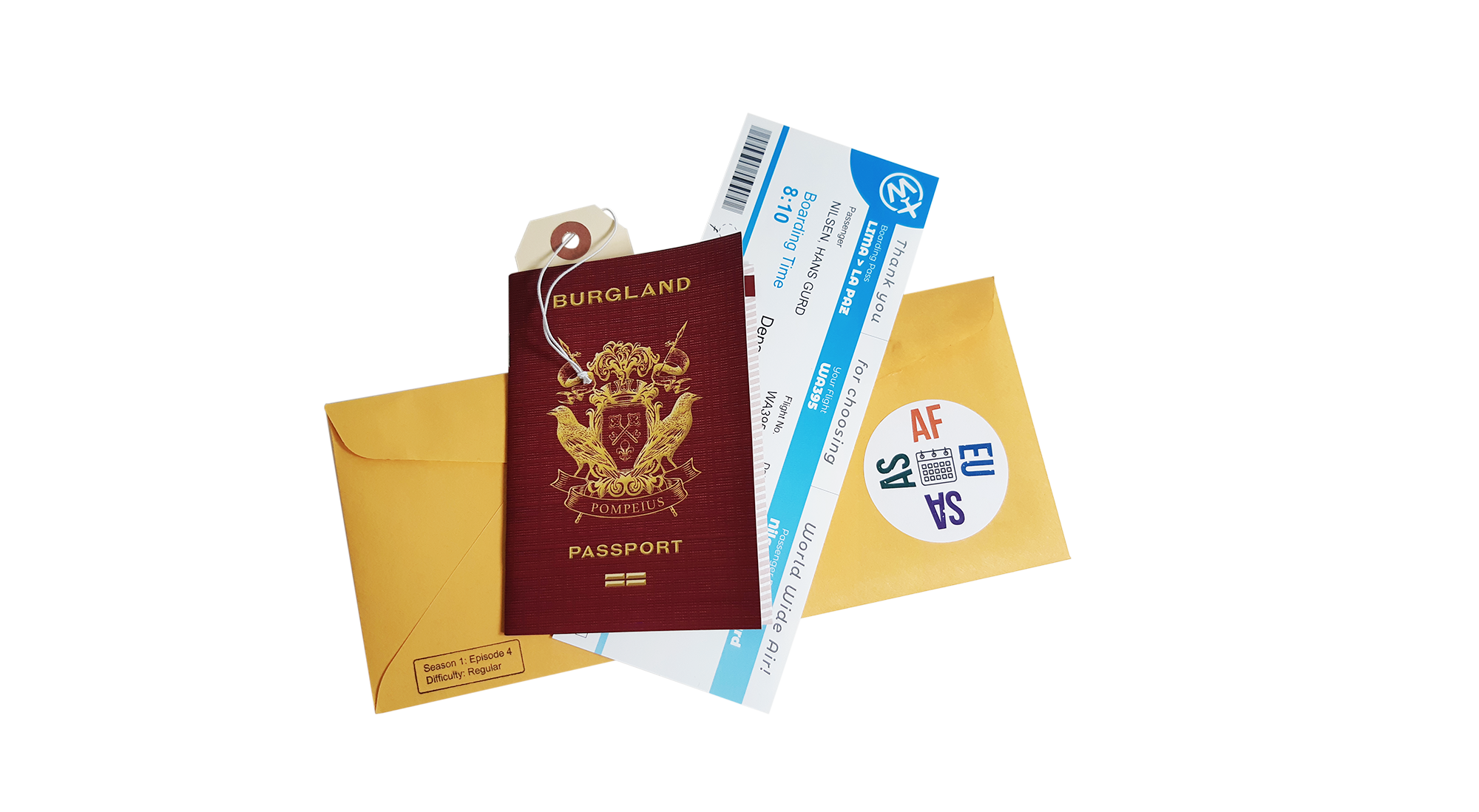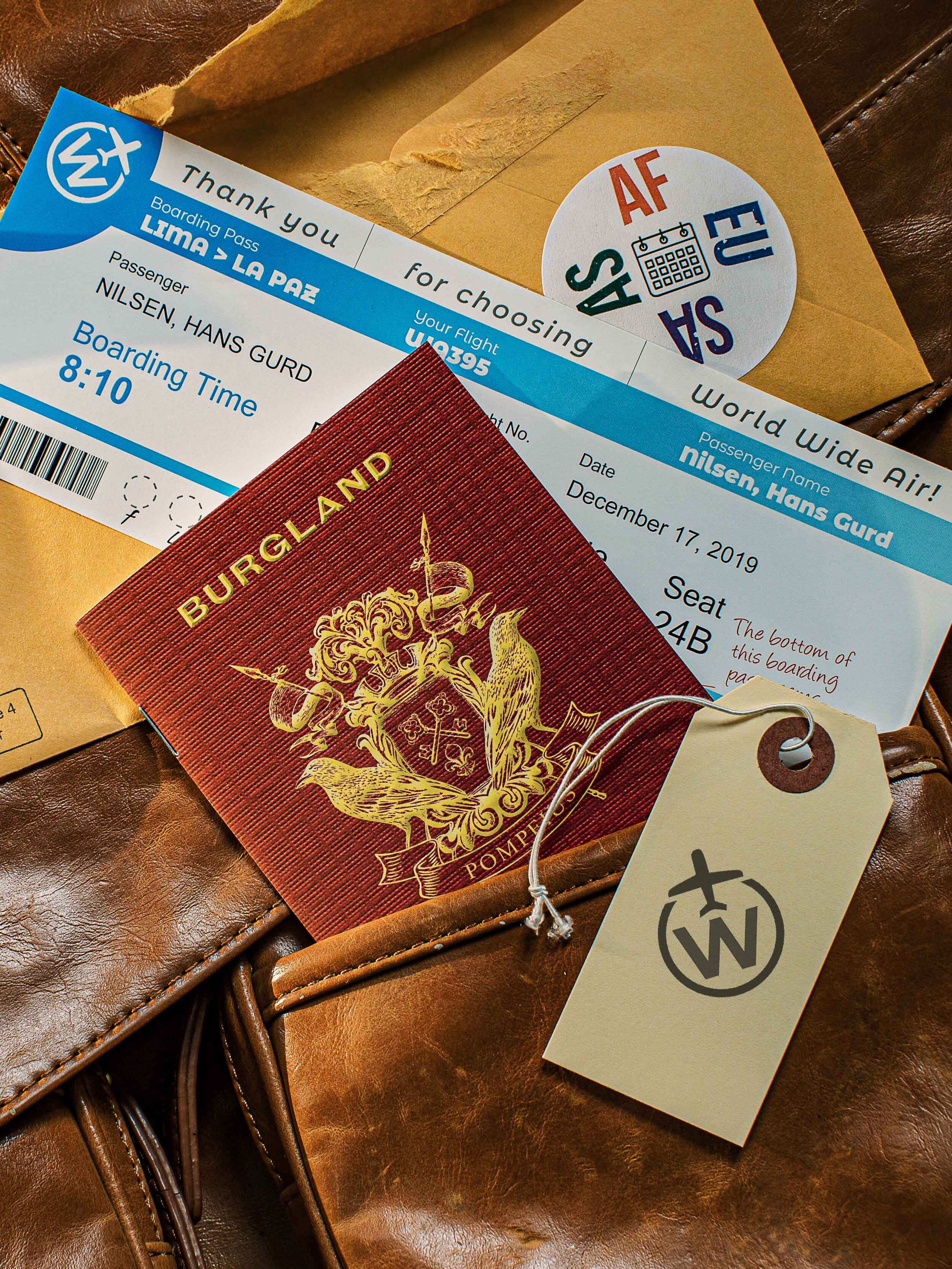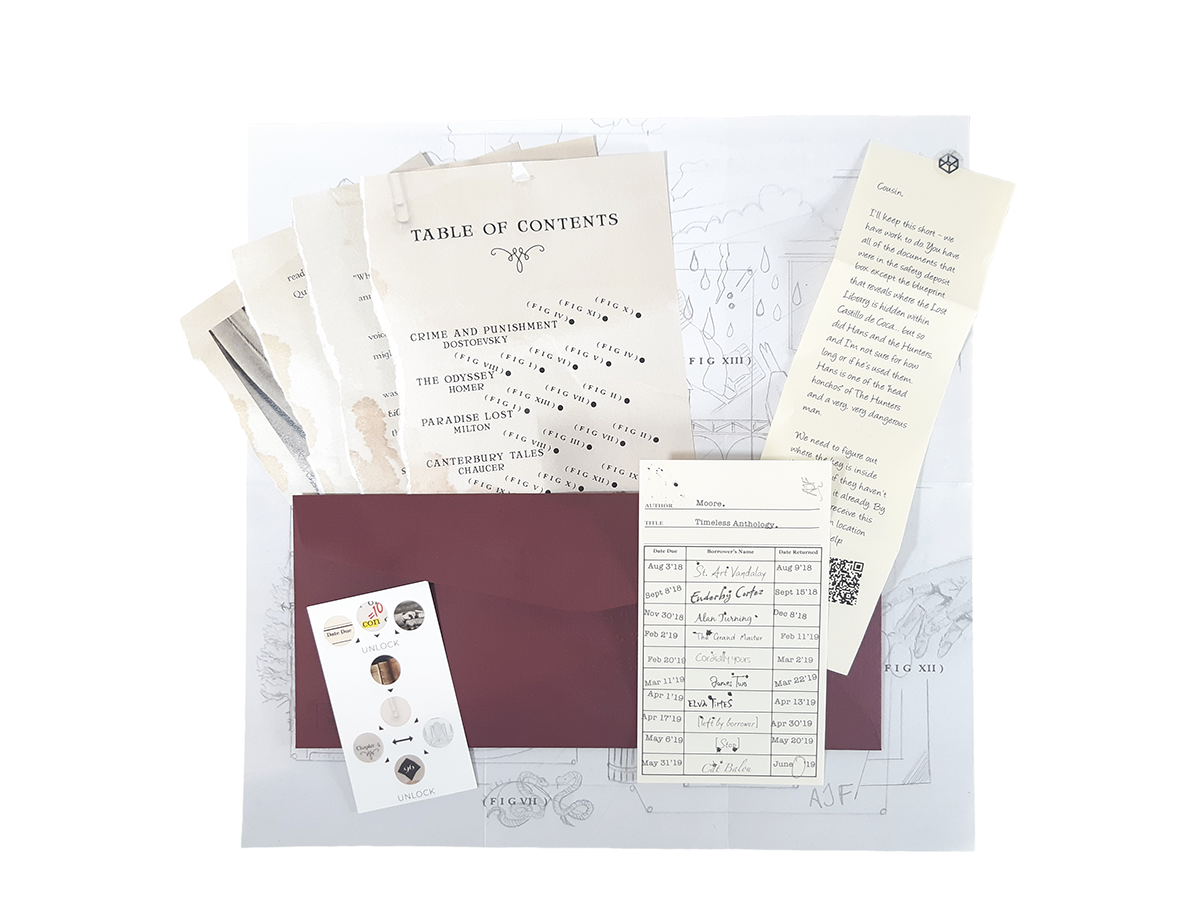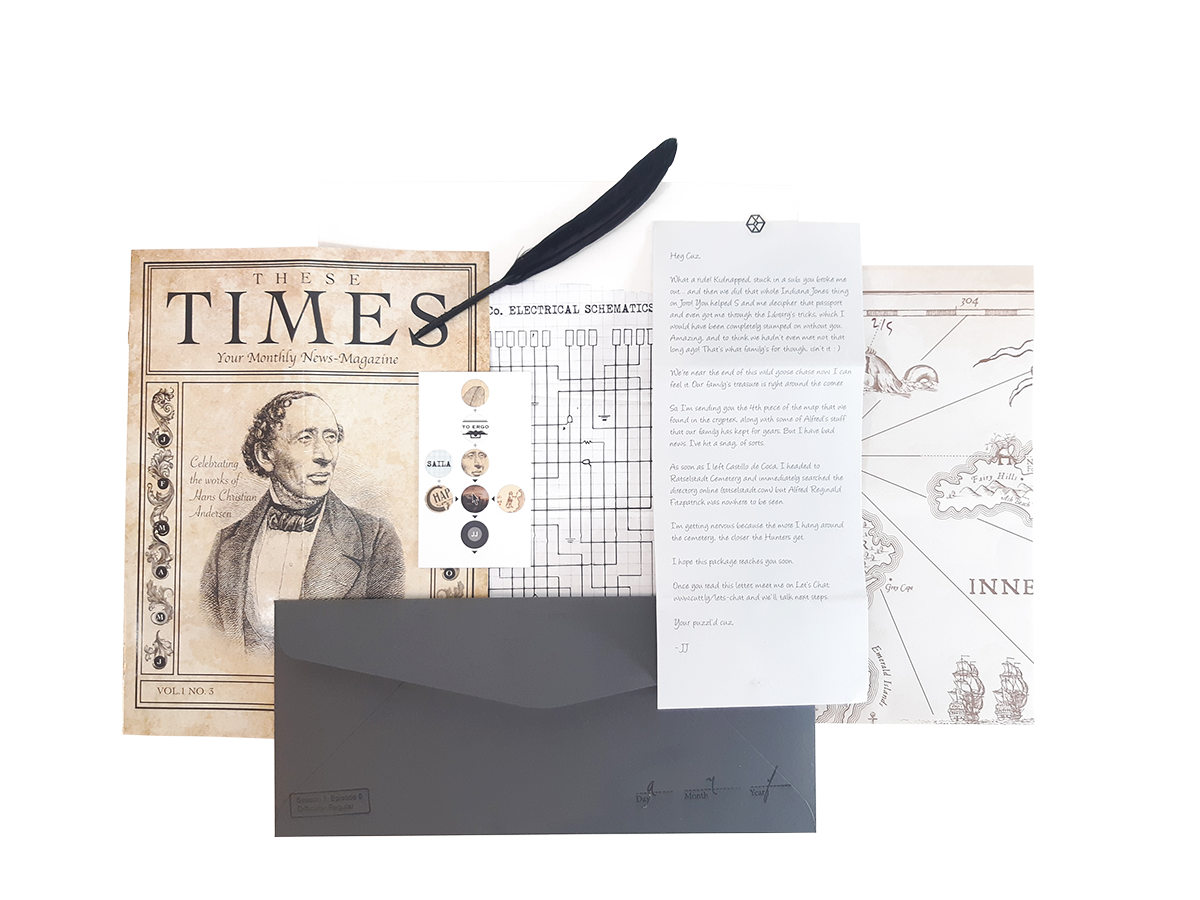Educational
ESCAPE ROOM IN AN ENVELOPE
Welcome to Escape Mail,
the international, award-winning, story-based puzzle adventure you can play in your classroom.
“To say these escape rooms were the highlight of the week is an understatement. I had students making their parents reschedule dentist appointments to ensure they could join in.” - Grade 8 teacher
What is Escape Mail?
It’s the original mind-blowing puzzle adventure that every student will love!
Escape Mail is an educational, story-based ‘escape room’ style game delivered to your classroom. Students will get immersed in the unfolding story as they work together to solve creative puzzles, uncover clues and decode riddles to help their mysterious cousin “JJ Fitzpatrick” find his family fortune. 21st Century Learning Competencies such as problem solving, critical thinking, communication, and collaboration, will be put to the test in this challenging adventure. Find out how HERE.
How Does It Work?
Step 1: Decide how many episodes you’d like to play↓
Each of the 12 episodes in Season 1 have their own satisfying conclusion. Start with Episode 1, or buy all 12 and follow the full narrative to completion.
Step 2: Decide how many copies of each episode you will need↓
Each copy of each episode is designed to be played by up to 4 or 5 students. For example, if you’ve got a class of 28 students, and want to play Episodes 1 and 2, you’ll need 7-9 copies of each episode, for a total of 14-18 copies.
Step 3: Decide which difficulty level to order↓
Beginner: Grades 4-6
Intermediate: Grade 7-9
Expert: Grades 10-12
*Note: Only Episodes 1 and 2 have a ‘Beginner’ edition.
Step 4: Order your games↓
If you need more than 15 copies of the games (regardless of which episodes) you qualify for a bulk discount and can order here. If you need less than 15 copies, you can checkout with a credit card here, or request an invoice to pay by cheque here.
Step 5: Your order is shipped↓
Once payment is made, your order will be shipped express for FREE the following business day and will arrive within 2-5 business days anywhere in Canada. There will be an envelope for the teacher inside the package which will provide you with access to all the tiered hints in case students get stuck along the way.
Step 6: Play!↓
Starting with Episode 1, hand out one copy to each group and watch the magic unfold, while you look like the hero! Each group will need a bit of tape (any kind will work, but scotch is ideal), scissors, an internet connected device, and away they go!
Step 7: Tips and tricks for the teacher↓
When your order is shipped you’ll also receive an email with a few basic details and suggestions to help you look like a hero facilitating this experience for your students.
Click here for more information about how this experience will support and enhance learning competencies in your classroom.
Click here (your eyes only) to take a peek at the hints and solutions for each episode in order to assist your students if they get stuck. Remember, getting stumped is part of the learning though! ;)
Start with Episode 1
The adventure begins with an encrypted introduction to a long-lost relative.
What is escape mail really like?
“Today my classes finished the third of three episodes of Escape Mail that we ordered from [Mobile Escape]. I’ve been doing this at home over the year and knew how great they were for my family, so had high hopes for my classes of gifted grade 8 students... To say these escape rooms were the highlight of the week (we did one a week for the past three weeks) is an understatement. I had students making their parents reschedule dentist appointments to ensure they could join in. I also noticed a sense of teamwork that we don’t often see with grade 8’s. Each team was competitive with the other teams, trying to solve each puzzle first. However within each team they communicated well, were respectful, open to each other’s suggestions, willing to look at things from different perspectives, and congratulatory towards each other when a seemingly strange idea worked. They didn’t give up when stuck, and persevered until they completed each episode. This doesn’t happen often with group work in grade 8, and never happens with every group in the class at the same time... Thanks for such a great end to our school year....
Your creativity, intelligence and ingenuity continues to amaze me.””
10,000+ happy customers
FAQs
How many people can play?↓
As many as you want! Each copy of Escape Mail is designed to be played by teams of up to 5, but teams of 3-4 are ideal. Order as many copies as you need.
How much does it cost?↓
It works out to being less than $4/student, and depending on how many copies you buy, it may be as little as $2.50/student. If you’re ordering more than 15 copies, the prices can be found here. If you’re ordering less than 15 copies, the price can be found here.
What’s Involved In Each Episode?↓
- Every episode comes in a standard envelope - deceptively simple!
- Most episodes require some physical coordination - cutting, folding, etc.
- Find clues concealed in the envelope as well as through the accompanying online media.
- Access tiered hints so you can move at your own pace.
- Follow a thrilling storyline unfolding over 12 episodes
What grades/ages is it for?↓
There are three difficulties to choose from:
Beginner: Grades 4-6
Intermediate: Grade 7-9
Expert: Grades 10-12
Thanks to the handy hints page with tiered hints for every puzzle as well as solutions, you’ll always be able to access the help you need to make sure the difficulty is just right.
How long does it take?↓
Each episode is designed to take about 60-90 minutes to complete. As the teacher, you can dictate this slightly depending on your propensity to provide clues to the students.
What kind of involvement is required from the teacher?↓
Once your package arrives, all you need to do is:
- Split your students into teams
- Make sure each group has a pair of scissors, tape, and an internet connected device
- Have your computer open (for your eyes only) to the hints page and provide hints to the students as needed
- Pat yourself on the back for providing an awesome learning experience for your students
Can it be replayed?↓
Elements from each episode will need to be cut, taped, and folded in order to solve some of the puzzles. As a result each copy can only be used once.
What Episode should I pick?↓
We definitely recommend starting with Episode 1. The adventure follows an overarching narrative across all 12 episodes, so Episode 1 is a natural place to start.
Learn more at our blog
What Teachers are Saying
“The Escape Mail was fantastic. The kids had a blast, they were focused and engaged for the full 2 hours it took to solve the mystery… thanks again for your creativity and making this work.”
“That was AWESOME! Thank you! We did at in our classes during the last week of school and it kept them busy for a perfect amount of time!”
curriculum connections
To see a detailed breakdown of how Escape Mail supports various Learning Competencies, click here:
Additionally, here you’ll find a list of ideas we think that might be a good idea either before and/or after this Episode of Escape Mail. These resources can easily be found on the web, but we did the legwork to make it a little easier. Enjoy!
AUXILIARY LEARNING SUPPORTS
Pre-Episode↓
A. Read a map and finding locations using coordinates (Math and Social Studies)
- Look at a map, and use different household objects to measure the distances (like a spoon, a pencil, or a ruler) and create a measurement system. For example: How many ‘spoons’ does it take to go from Calgary to Vancouver?
- Map and Coordinates Lesson Plan Link
B. Geometric transformations (translation, rotation, reflection) (Math)
- Look at how objects can move from one place to another on a coordinate plane (just use graph paper, or a 1 inch by 1 inch grid that you can hand draw with a ruler) Objects can move up, down, left, and right. You can see the distance that they move using the graph paper. Objects can also rotate and reflect across a line.
- Geometric Transformations Lesson Plan Link
C. Using symbols to represent letters (Math)
- You can create your own cipher at home by using numbers to represent letters! For example, A=1, B=2, C=3. Leave secret messages around the house and let your kids solve the puzzle!
- Letter Number Cipher link
D. Using context clues to interpret meaning (ELA)
- Text features are pictures, symbols, notes, headlines, titles, and altered text that emphasize importance and relevance in a body of writing. Look at a newspaper article, and identify all of the things that aren’t “regular text”. Show your students how those elements signify importance and message.
- Text Features Lesson Plan link
Post-Episode↓
Write a friendly letter to a character in the story (ELA)
E. A friendly letter is an informal way to send a message. While this is not as common as it was in the past, writing an informal letter to a friend or family member is a nice way to say hello! Have your students write a letter to their long lost cousin - J. Jordan Fitzpatrick! They can ask him about his adventures or describe how they solved the puzzles in Episode 1. If your students want to mail their letter to J. Jordan Fitzpatrick and receive a response, use the following address:
Mobile Escape
246 Stewart Green SW
Unit #6199
Calgary, Alberta
T3H 3C8Friendly Letter Lesson Plan link
F. Make predictions based on elements of the story (ELA)
- Students have learned quite a lot in Episode 1! After the chilling conclusion, many questions have been left unanswered. Have students make predictions about the fate of their cousin JJ by creating a bulleted list of possibilities.
- Making Predictions Lesson Plan link
G. Write a reflective journal describing events that took place in the story (ELA)
- Journaling is an excellent way for students to think deeply about their experiences. Have students write a brief journal entry that discusses their thoughts, memories, and feelings about the story of Episode 1.
- Journaling Lesson Plan link
H. Create a map with locations and coordinates including other systems of measurement (Math and Social Studies)
- Now that students have seen a make-believe map, have them create their own! They can draw a landmass of their own creation, but make sure they use a scale to measure distances (include this on the side of the map like our map of the islands).
- Map Making Lesson Plan link
I. Create a cipher using mathematical functions (Math)
- Students can use a cipher with more than just numbers representing letters. Using a mathematical function adds another dimension to the cipher that makes it even more challenging! For example, if A=2, B=3, C=4, but the code to solve is 4 6 8, students have to divide by 2 in order to get the correct numbers for their cipher.
- Math Cipher Lesson Plan link
Alberta Curriculum Connections↓
Puzzle 1
- Arrange events, facts and/or ideas in sequence (K-6 Social Studies)
- Work independently or with others to carry out the identified procedures (K-6 Science)
Puzzle 2
- Collect, display and analyze data to solve problems. (K-6 Math)
- Apply, flexibly, knowledge of phonics, sight vocabulary, structural analysis, language and context clues, depending on the purpose and rate of reading (K-9 ELA)
- Make predictions based on organized information (K-6 Social Studies)
- Attempt, with guidance, a variety of strategies to complete tasks (K-6 Science)
Puzzle 3
- Describe, compare and construct 2-D shapes (K-6 Math)
- Connect gathered information to prior knowledge to reach new conclusions (K-6 ELA)
- Describe and analyze position and motion of objects and shapes (K-6 Math)
- Identify materials and how they are used (K-6 Science)
Puzzle 4
- Construct and interpret concrete graphs and pictographs to solve problems. (K-6 Math)
- Describe and analyze position and motion of objects and shapes (K-6 Math)
- Combine ideas and information from several sources (K-6 ELA)
- Attempt a variety of strategies to complete tasks (K-6 Science)
Puzzle 5
- Use patterns to describe the world and to solve problems. (K-6 Math)
- Gather information on a particular topic from a variety of sources, e.g., illustrations, photographs, videos, objects, auditory cues (K-6 Social Studies)
- Explore oral, print and other media texts from various communities (K-9 ELA)
Puzzle 6
- Examine ideas and information from varied sources (K-6 Social Studies)
- List significant ideas and information from oral, print and other media texts (K-9 ELA)
- Collect, display and analyze data to solve problems. (K-6 Math)
- Apply observation and inference skills to recognize and interpret patterns and to distinguish a specific pattern from a group of similar patterns. (K-6 Science)
Puzzle 7
- Process information from more than one source to retell what has been discovered (K-6 Social Studies)
- Describe and analyze position and motion of objects and shapes (K-6 Math)
- Apply knowledge of the properties and interactions of materials to the investigation (K-6 Science)
CTF Learning Outcomes
- I make decisions in response to challenges.
- I adapt to change and unexpected events.
- I solve problems in response to challenges
- I appraise the skills, knowledge and technologies used to respond to challenges.
BC Curriculum connections↓
Puzzle 1
- Make observations in familiar or unfamiliar contexts (Science) Identify key features or potential users and their requirements (Applied Design, Skills, and Technology)
Puzzle 2
- Make predictions about the findings of their inquiry (Science) Recognize an increasing range of text structures and how they contribute to meaning (English)
- Identify and use sources of information (Applied Design, Skills, and Technology) Ask questions, corroborate inferences, and draw conclusions about the content and origins of different sources (Social Studies)
Puzzle 3
- Select and apply digital tools to collect, organize, and analyze data to evaluate theories or test hypotheses (Digital Literacy)
- Use reasoning to explore and make connections (Math)
- Test the first version of the product or the prototype (Applied Design, Skills, and Technology)
Puzzle 4
- Transfer and apply learning to new situations (Science)
- Visualize to explore mathematical concepts (Math)
- Explore and test a variety of materials for effective use (Applied Design, Skills, and Technology)
Puzzle 5
- Identify patterns and connections in data (Science)
- Represent mathematical ideas in concrete, pictorial, and symbolic forms (Math)
- Apply a variety of thinking skills to gain meaning from texts (English)
Puzzle 6
- Synthesize ideas from a variety of sources to build understanding (English)
- Represent mathematical ideas in concrete, pictorial, and symbolic forms (Math)
- Select and use the appropriate tools and digital resources to accomplish a variety of tasks and to solve problems. (Digital Literacy)
- Identify some of the assumptions in secondary sources (Science)
Puzzle 7
- Students apply digital tools to gather, evaluate, and use information (Digital Literacy)
- Story and text evidence (English)
- Identify key features or potential users and their requirements (Applied Design, Skills, and Technology)
ONTARIO CURRICULUM CONNECTIONS↓
Puzzle 1
- Generate, gather, and organize ideas and information (Writing)
- Read and demonstrate an understanding of a variety of literary, graphic, and informational texts, using a range of strategies to construct meaning (Reading)
Puzzle 2
- Interpret media texts, using overt and implied messages as evidence for their interpretations (Media Literacy)
- Identify the conventions and techniques used in some familiar media forms and explain how they help convey meaning and influence or engage the audience (Writing)
- Identify a variety of text features and explain how they help readers understand texts (Reading)
Puzzle 3
- Use a variety of appropriate visual aids (Communication)
- Apply developing reasoning skills (e.g., pattern recognition, classification) to make and investigate conjectures (e.g., through discussion with others) (Math)
- Create a variety of representations of mathematical ideas (e.g., by using physical models, pictures, numbers, variables, diagrams, graphs, onscreen dynamic representations), make connections among them, and apply them to solve problem (Math)
Puzzle 4
- Use technological problem-solving skills (see page 16) to design, build, and test devices (Science)
- Use a variety of appropriate visual aids (Communication)
- Develop and apply reasoning skills (e.g., classification, recognition of relationships, use of counter-examples) to make and investigate conjectures and construct and defend arguments
Puzzle 5
- Make judgements and draw conclusions about the ideas and information in texts and cite stated or implied evidence from the text to support their views (Reading)
- Analyse texts and explain how various elements in them contribute to meaning (Reading)
- Identify the purpose and audience for a variety of media texts (Media Literacy)
- Select and use a variety of concrete, visual, and electronic learning tools and appropriate computational strategies to investigate mathematical ideas and to solve problems (Math)
Puzzle 6
- Use technological problem-solving skills (see page 16) to design, build, and test devices (Science)
- Identify a variety of organizational patterns in a range of texts and explain how they help readers understand the texts (Reading)
- Demonstrate an understanding of magnitude by counting forward and backwards by various numbers and from various starting points (Math)
- Select and use a variety of concrete, visual, and electronic learning tools and appropriate computational strategies to investigate mathematical ideas and to solve problems (Math)
Puzzle 7
- Identify a variety of reading comprehension strategies and use them appropriately before, during, and after reading to understand texts (Reading)
- Use a variety of appropriate visual aids (Communication)
- Make connections among mathematical concepts and procedures, and relate mathematical ideas to situations or phenomena drawn from other contexts (Math)
Ready to Try
Escape Mail?
educational games
Looking for more games?
Mobile Escape created a Mars-themed rural safety game for the organization Ag for Life.
If you would like to order this game for your class, please visit Ag for Life’s website.
Coming Soon: Climate Change Escape Game
Want to stay in the know?
Sign up to hear more about the development of this game.

